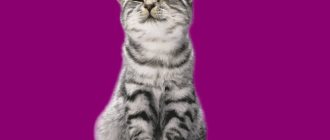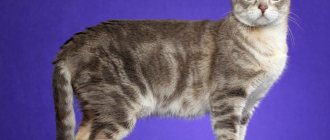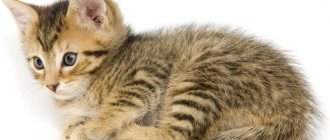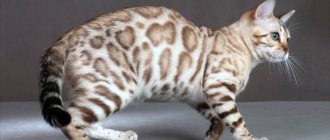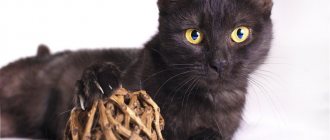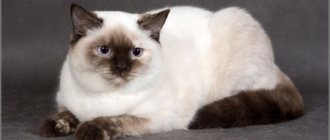British cats, whose breeding began at the end of the 19th century, are to this day the true pride of Great Britain. Large cats with plush fur, according to legend, inherited their smile from the Cheshire cat. The first snow-white beauty belonging to this breed was officially presented at the exhibition in 1987. To this day, the colors of British cats are of particular interest to cat lovers. There are no British Folds; this anatomical feature is inherent in Scottish cats.
Since then, the popularity of the breed has been steadily growing. The British attract not only their intelligent character and plush fur, but also a huge variety of colors, of which there are more than 25 types. A table with photos will help you study the colors of British cats, as well as a description of the types and types of colors of this breed. Among the color range of wool there are very rare combinations that are extremely highly valued by both professional breeders and breed lovers. Let's figure out what colors British cats come in.
Types of colors
Selection work on representatives of the British breed, involving various bloods, has led to a variety of both colors and breed types. If initially the British had short hair with a thick undercoat, then crossing with the Persian cat made it possible to obtain semi-long-haired animals. The colors of British longhair cats correspond to the colors of shorthair cats.
Many people only think of Britons as smoky, blue or tabby cats and don't even realize how many colors the breed has. Even a pair of quite ordinary parents can produce a kitten of a rare color.
To organize the variety of colors of British cats, they are divided into types and groups according to color, pattern and method of pigmentation.
Types of colors of British cats:
- solid (or plain);
- typed: smoky, veiled, shaded;
- gold;
- silver;
- tortoiseshells;
- color point;
- particolors: harlequin, bicolor, van, mitted;
- tabbies: spotted, striped, marbled, ticked.
A table of the colors of British cats will help you imagine all the diversity.
History of the origin of the Asian breed
It was no coincidence that the world saw Asian tabby cats. Their appearance is the result of the persistent, painstaking work of felinologists. Scientists have decided to create a new breed of domestic cat with an athletic, but at the same time graceful physique. They should be proud and majestic, but not questioning themselves.
The British made their dream come true in the early 1980s. The blood of three outstanding “parents” flows in the veins of these marvelous creatures. First, a short-haired, muscular Burmese cat was crossed with a Persian chinchilla with a long snow-white coat. The grown-up hybrid was mated with an Abyssinian who loves water, and then again with a Persian.
Everything turned out just as the cat lovers had imagined - the result was an animal with the structure of a Burmese, the character of an Abyssinian ancestor and the gloss and restraint of a Persian aristocrat. However, the Asian cat inherited all the best features from this lovely trio. The combination of their varied colors gave the world of cats several new species of one group: smoky, Burmilla, Asian with even color, tabby and Tiffany.
Ten years later, in the 90s, the Asian tabby received recognition from serious world felinological organizations (among them was WCF). Initially, these cats had only 3 coat colors: plain, thick brown, and silver. However, today, thanks to the efforts of breeders, everyone can find a pet with a fur coat they like.
The breed is successful in many countries, although in the CIS countries Asian cats are just beginning to conquer breeders. But in Russia these animals are practically never found and are extremely difficult to buy. Accordingly, this rare feline is worth, according to various sources, from several tens of thousands of rubles to a thousand dollars. The owner of this amazing creature can be called lucky. But the Asian tabby is not only a luxury item, but also a gentle, loyal friend that no amount of money can buy.
Blue solid
This is the color that comes to mind when thinking about the British, so we'll start with it. It is often called classic, or simply gray. The coat should be a single color, the undercoat may be lighter, but white hairs are not allowed. A lighter color is considered valuable. A small kitten may have stripes that disappear as they age. The beautiful rich amber eye color of blue Britons develops with age, although kittens are born with gray and blue irises.
Proper feeding of a Siberian
Some representatives of Siberian cats can be picky about food, since animals living in nature are accustomed to natural food. But usually there are no problems with feeding pets.
Particular attention should be paid only to small kittens that grow quickly and require increased nutrition. Until they are three months old, they should be fed six times a day with a balanced, varied food designed for babies.
The food of pregnant and lactating mother cats should be high-quality and rich in vitamins. She should eat to her fill, but the cat should not be allowed to overeat so that the animal does not gain excess weight. A cat's diet during pregnancy and lactation should be higher in calories and contain vitamins and minerals. Lack of nutrients will negatively affect the health of the offspring. One litter of a Siberian cat can have from four to eight kittens.
Siberians can and should be fed natural products:
- Meat, which supplies protein to the animal's body. You can only give lean types of meat, which includes boiled or raw beef, chicken fillet, turkey or other poultry. A pet should eat from one hundred to one hundred and forty grams of meat products per day.
- In combination with other products or separately, you can give one boiled egg, but not more than two to three times a week.
- Your pet's diet should include fish or seafood. Preference should be given to saury, flounder, cod, and boiled shrimp.
- Separately from meat, it is recommended to feed animals with fermented milk products in the form of low-fat kefir or cottage cheese.
- You can mix boiled zucchini, carrots and cabbage with meat, which are a source of vitamins.
Under no circumstances should you feed your pet food from the owner's table. Eating fried, salty, smoked, spicy, sweet and fatty foods can have a negative impact on his health.
Cats should always have free access to clean drinking water, for which a separate bowl is provided. It is recommended to give sprouted grains, which help get rid of swallowed hair, stimulate blood circulation and are sources of vitamins. Green oats are the best food for cats to eat.
Plain
In addition to blue, there are six more solid colors: black, white, chocolate, lilac, red, cream. The color is uniform and uniform, without white hairs, spots or patterns. The wool is soft, thick, plush.
Charcoal black plush Britons look extremely impressive, they have rich pigmentation of the undercoat, fur and skin, but purchasing such a kitten is not easy. This is due to the fact that during adolescence, kittens can change their coat color to chocolate.
The fur of a white British cat is snow-white, without yellowness or spots. In kittens, blue or black stripes on the forehead are acceptable, which disappear without a trace with age. It is difficult to obtain kittens with perfectly white fur, and breeding cats of this color is associated with the risk of producing sick offspring. Since 1997, breeding work has not been carried out with this color.
In warm chocolate color, richness and depth of shade are appreciated. The darker the color, the better. This color is called havana, or chestnut.
Considering the solid colors of British cats, lilac is the most difficult to imagine. This color is a combination of pink and blue. The paw pads and nose are colored to match the fur. Obtaining this color is the result of professional breeding. There is no gene responsible for the purple color. The goal is achieved by a rare combination of parental genes. Kittens are born a delicate, almost pink color, and the color of an adult animal resembles a latte.
Red British cats are most often called ginger cats. The wool is uniformly dyed, without stains or patterns. The nose and paw pads are brick red. Intensity of color is valued.
Delicate creamy Britons are often called beige or peach. Their nose and paw pads are pink.
Caring for smoke-colored cats
Smoky cats are very demanding in care, because... In unkempt animals, the fur becomes discolored, fades, and “rusts.” Care means not only regular brushing and combing of the coat, but also a balanced diet, and also protection from frequent, prolonged exposure to sunlight.
It is recommended to wash black show cats with professional shampoos that enhance the black color. And, oddly enough, it is better to wash black smoky cats with whitening shampoos for white cats. The enzymes contained in such shampoos perfectly whiten the root zone, and make the ends of the hair appear shiny.
In addition to shampoo, when grooming, you can use a balm to volume the coat. Then the hairs will be raised and show off the haze more favorably.
You also need to carefully monitor traces of tears, which dry up and become crusts, and after they are removed, if you clean the area around the eyes irregularly, yellowish spots may remain. It will take a long time to get them out. Therefore, it is better to regularly use cleansing eye lotions for preventative purposes as tear stains appear.
Long-haired smoke-colored Scots need to be brushed frequently to prevent mats from forming. If in cats of a different color the tangles can simply be cut out, then in smoky cats such manipulation will lead to dark guard hairs growing in place of the light undercoat - a dark spot will appear on the body.
Furminators are also not suitable for combing such cats. The fact is that the furminator can damage the undercoat - the result can be as disastrous as in the case of cutting out the mat. Also, such cats should never be trimmed. It is better to bathe thoroughly during molting and comb it either with a regular comb with fairly sparse teeth, or with a special silicone paw.
And, of course, one should not allow heavy or prolonged shedding in smoky animals, so that they do not lose their undercoat, which forms all the beauty, and also so that the coat does not fade. In order for molting to be less intense, a balanced diet and vitamin intake in courses are necessary if the cat is on a natural diet or on non-vitaminized factory feed.
Article continues after advertisement
Rare colors of British cats
Today, relatively new and rare uniform colors stand out - cinnamon and fawn. Dark colors of British cats are dominant, so light-colored kittens are rarely born.
Cinnamon is a very rare and desirable color, its name comes from the English cinnamon, which translates as cinnamon. The color is similar to lightened chocolate. The gene for this color, discovered 50 years ago, is recessive, so cinnamon kittens are born quite rarely.
Fawn is an even rarer color, which is a bleached cinnamon. It was recognized quite recently, in 2006, and is of particular interest to breeders, as it makes it possible to develop new lightened colors.
Fawn-like kittens, i.e., fauns, and cinnamon cinnamon kittens are classified as cream and blue at birth. To identify a rare color, a DNA examination is carried out, which confirms that the animal belongs to a rare color.
Signs and superstitions
Gray cats have long been considered mystical creatures, surrounded by many secrets. Therefore, events associated with the owners of the blue fur coat were given special significance:
- Both an ordinary and a purebred gray cat are considered a money talisman. Therefore, everyone who wants to improve their financial situation is recommended to get such a pet.
- Gray cats get along well with brownies. And those who want to pacify an aggressive household spirit can try to do this with the help of a blue pet.
- Gray cats are called family psychologists. It is believed that owners of blue wool contribute to the harmonization of relationships between loved ones.
- If a smoky cat crosses the road, you need to say: “A gray cat is a happy path,” and then good luck and happiness will accompany the person.
- Animals with ash-blue fur protect their owners from damage and the evil eye. Therefore, if a gray cat comes into the house, you should not chase it away.
- To protect yourself from troubles for the whole day, the first thing you need to do after waking up is pet your smoky pet.
- It is generally accepted that the owners from whom a gray cat has escaped are in for trouble.
Although gray cats are much less common than white-red, black or cream-colored cats, they have managed to gain a reputation as aristocratic and highly intelligent animals. Moreover, many owners of blue fur coats sincerely believe that their pets attract prosperity and success into the house.
Silver and gold
Silver color is one of the most popular among British cats. It can be of the following types:
- shaded;
- veiled;
- smoky;
- tabby
Golden color is also not found in its pure form. This bright color is one of the most expensive among British cats. It can be represented by the following types:
- shaded;
- veiled;
- tabby
Ticked tabby, shaded and veiled colors are called chinchilla. It is the representatives of golden and silver colors that are called chinchilla and golden chinchilla.
Tortoiseshells
Tortoiseshell cats are a favorite among breeders. From these mothers you can get a wide variety of offspring. Their unique color, also called torti, combines two groups of colors at once - red and black, and this is possible only in females. Tortoiseshell cats can only be born as a result of a genetic anomaly - mosaicism. Such animals are infertile and have the XXY genotype.
The tortoiseshell color consists of black and red spots evenly distributed throughout the body (or derivatives of these colors, for example, blue and cream, chocolate and cream, lilac and cream, etc.).
There are a huge number of British tortoiseshell species:
- Classic turtle (black-red, chocolate-red, lilac-cream, fawn-cream, cinnamon-red, lilac-cream).
- Smoky turtle (black and red smoky, chocolate red smoky, etc.).
- Tortoiseshell tabby, or torby (black and red tabby, chocolate red tabby, etc.).
- Tortoiseshell color point, or tortie (tortie point - black tortoiseshell, blue cream point - blue tortoiseshell, etc.).
- Bicolor tortoiseshells or calicos (black and red bicolor tortoiseshell, etc.).
- Bicolor tabby tortoiseshell, or torbico (marbled, striped, spotted bicolor tortoiseshell).
A tortoiseshell kitten can be born from parents of different color groups, for example, the mother is red and the father is black.
Tabby
The patterned cats resemble wild ones in color. They have spots, stripes, rings on the body and paws and the obligatory letter "M" on the forehead. Tabby color also has several types:
- Spotted, spotted, or leopard print is the most common tabby. Cats of this color look like miniature leopards.
- Striped, mackerel, or tiger. Narrow frequent stripes should not be interrupted or intersect with each other. After a year, the brindle color may turn into leopard if the stripes begin to break up.
- The merle color is very impressive, bright and the most complex of the tabbies. The stripes on the back are straight, but on the sides they form clearly visible circles and rings.
- The ticked color stands apart - it has no pattern and looks like a plain one with “spraying”. Resembles shaded or veiled. Each hair has its own stripes.
Features of participation in the exhibition
Any British cat that meets the stated standards can take part in the exhibition. It is important that the animal is healthy, has no external physical defects and has a calm emotional background. A pet that is aggressive or very frightened will most likely face disqualification.
Preparing the appearance
It is best to start preparing your pet for the exhibition in advance:
- If a Black British cat's coat feels greasy to the touch or has lost its characteristic shine, you should bathe the cat with a special shampoo a few days before the event. For animals with dark fur, the Royal Groom Black Pearl cosmetics line and similar ones are ideal. To improve the quality of the fur coat, it is recommended to use conditioners of the same brands.
- To get rid of tail fat, it is better to clean the animal’s anal glands in advance.
- The cat's eyes and ears should be perfectly clean, without discharge, scabs or suppuration.
- Nails need to be trimmed carefully.
Nails will need to be trimmed before the show.
- Brush your teeth at least three days before the exhibition.
- It is strictly prohibited to tint or tint the animal.
- If there are single white hairs on the fur, they need to be removed.
- To avoid fading of the fur, show animals should not be allowed to sunbathe.
The cat will have to be banned from sunbathing before the exhibition
At the show, cats are evaluated on a 100-point system.
Table: scoring system according to association standards
| Options | WCF | FIFE | CFA |
| Body | 20 | 20 | 35 |
| Head | 30 | 30 | 25 |
| Wool | 10 | 10 | 20 |
| Color | 35 | 35 | 20 |
| Condition | 5 | 5 | — |
The judges place the main emphasis on the type of head, quality of color and texture of the animal's coat.
Black Britons not only participate in exhibitions, but also quite often take prizes
Disqualification of a black British man
Reasons why a black British cat is disqualified:
- white hairs, medallions, brown or gray undercoat;
- pale, inappropriate eye color or greenish rim around the iris in adults;
- non-black color of paw pads or nose;
- non-standard number of fingers;
- defects and pathologies of the tail, including kinks and kinks;
- long or fluffy coat, too long or light undercoat;
- significant violations of the dental system;
- overshot or undershot exceeding 2 mm.
At the exhibition you can not only receive well-deserved awards, but also find out the opinion of experts about the animal, get the necessary recommendations, and also find a worthy pair for mating. But if the judges did not rate the cat very highly, there is no reason to be upset, because for a loving owner, his pet has practically no shortcomings.
Color point
Color-point Britons have a light body color and dark markings on the face, ears, paws, and tail - points. This color is also called Himalayan or Siamese. The color of the points corresponds to one of the main colors, and the body color is in harmony with it.
Types of color point:
- solid;
- shaded;
- veiled;
- bicolor;
- smoky;
- turtle;
- tabby
Colors with white
The combination of any basic, patterned or tortoiseshell color with white is called the general name bicolor - these are colored spots without white fibers, with clear boundaries. There are several groups of this color:
- Bicolor – from 1/3 to 1/2 white – muzzle, chest, paws, belly. Colored - one or two ears, head, back, tail.
- Harlequin - only 5/6 white - collar, neck, chest, paws.
- Van – main color – white. Colored spots on the head, but the ears are white, colored tail, colored spots on the back are allowed.
- Tricolor, or calico, is a tortoiseshell (i.e., two-color) color with white.
- Mitted – is not recognized as a standard and is considered a flaw. There is little white, no more than 1/4, the head, neck, collar, belly and paws are white.
Now you know what the colors of British cats are. The table with photos helped us understand the variety of types and types of colors.
Diseases
Prevention of deworming - from 1-2 times a year to 1 time every 4 months (depending on the situation). If a cat eats meat, i.e. the risk of infection is high - worms should be removed once a quarter. This is also done before vaccination. Suitable drugs: Milbemax for cats, Drontal plus, Cestal, Praziquantel.
When buying a kitten from a cattery, you can be sure that it will be fully vaccinated. You will monitor the remaining vaccinations yourself and do them annually. Mandatory vaccinations: against rabies, panleukopenia, calicivirus, herpes virus infection). This disease can be brought not only from an infected animal, but even on shoes from the street. Suitable vaccine: Purevax (French).
Photo of an Asian tabby cat
Optional vaccinations: against viral peritonitis, leukemia, chlamydia and immunodeficiency. They are worth doing if your pet is at increased risk of infection. Suitable vaccine: Purevax RCPCh, Purevax FelV (French).
Are you taking your tabby to the country? Be sure to vaccinate him against ringworm (lichen). Domestic vaccines - Polivak, Microderm - will do an excellent job of protecting your pet from this unpleasant disease. However, vaccination will not be superfluous even for a cat that sits at home and does not go outside (there are known cases of infection through clothes and shoes).
If you do not plan to breed, spay or neuter the animal. This way it will not suffer from the influence of sex hormones.
If you notice that your pet has become lethargic, refuses water and food, or sleeps poorly (not to mention such obvious signs of illness as vomiting, nosebleeds, drowsiness, and restlessness), consult a doctor immediately.
Diseases can be divided into several groups:
- parasitic (fleas, ear mites, worms);
- infectious (rabies, respiratory diseases, panleukopenia);
- skin (ringworm, dermatitis);
- pathologies of internal organs and systems (pyelonephritis, urolithiasis, diabetes, myocarditis, myocardosis, gastritis, colitis);
- eye diseases (conjunctivitis, blepharitis, prolapse of the third eyelid);
- ear diseases (otitis media, abscess);
- gynecological diseases (uterine torsion or hernia, vaginitis);
- pathologies of the musculoskeletal system (arthrosis, arthritis).
The sooner treatment begins, the easier it will be to cope with the disease. Neglected diseases become chronic.
Expert's opinion Vera Ivanovna Dusheba In 2010 she graduated from the Moscow State Academy of Veterinary Medicine named after K.I. Scriabin with honors, specializing in veterinary medicine. I regularly attend veterinary conferences, congresses, and webinars.
When planning to buy a tabby kitten, remember: in Russia few people breed this breed. Therefore, do not take risks and do not turn to private sellers in an attempt to save time or money: this is a risky undertaking and most often such maneuvers do not live up to expectations. The baby should have clean ears and eyes, without purulent discharge or wounds, a pink tongue and gums, and fresh breath from the mouth. Ask to see documents: birth certificate, pedigree, veterinary passport and green card (if you plan to purchase abroad). Approximate cost of a kitten: 50-70 thousand rubles.

